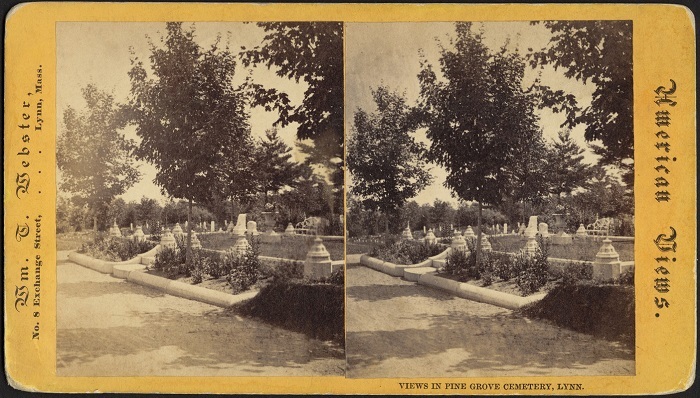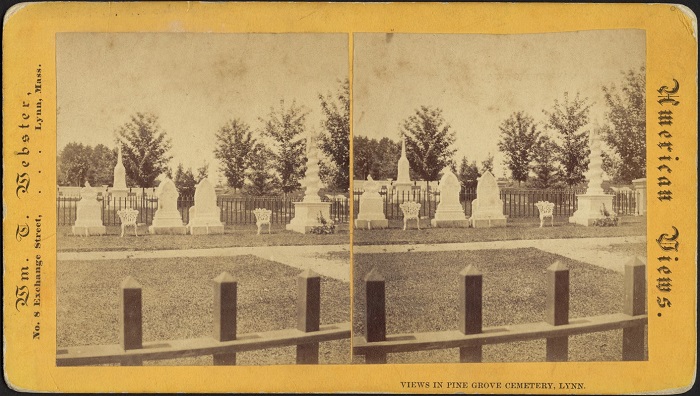Established in 1850, the Pine Grove Cemetery is a historic cemetery in Lynn, Massachusetts. The cemetery is approximately 250 acres in size and has over 80,000 headstones, monuments, mausoleums and footstones.
In 1848, Lynn historian James Newhall described the site proposed for Lynn’s new cemetery as a wilderness:
“It was a very wild place till within a few years. A high woody hill rose in the rear, a tangled swamp was on either hand, with a weedy brook winding through; while in front beyond a little area of brambles and rank vegetation wound the street.”
The land the cemetery is located on was selected because of its beautiful natural features, such as its hills, valleys, streams and diverse types of vegetation including the native white pine the cemetery is named after. Many of the avenues within the cemetery are also named after the various trees located in the cemetery.
At the time it was established, the cemetery was a wooded area with rocky outcrops and steep, uneven slopes. To construct the cemetery, workers regraded the southern section of the land and created the entrance drive off Boston Street to provide access to the new burials.
The cemetery was officially consecrated on July 24, 1850 and the address was delivered by Reverend Charles C. Shackford of the Unitarian Society.
The cemetery has two small hills in the southeast section, Mount Dearborn and Forest Rock, which provide dramatic views across the water to the city of Boston.
The oldest sections of the cemetery, located in the southwestern section of the cemetery, were designed by General Henry A.S. Dearborn, who also designed several other cemeteries, including Mount Auburn Cemetery in Cambridge and Watertown.
As the cemetery grew, it expanded to the north as additional space was needed. The newest sections of the cemetery, which were developed in the past 50 years, are located around the perimeter of the northern part of the cemetery.
The cemetery was originally a private cemetery but was acquired by the city of Lynn in 1854.
In 1866, the local Grand Army of the Republic chapter of Civil War veterans erected the Lynn Civil War Memorial in section 29 of the cemetery. It is one of the tallest monuments in the cemetery and features a 5 ½ foot granite figure of a Civil War soldier on a 20-foot granite base and pedestal.
In 1869, the Keeper’s House was constructed just inside the main entrance, making it now the cemetery’s oldest building. It was a two-story building in the Second Empire style with a tower, a brick foundation, brick walls, brownstone trim and a slate shingle roof.
Also in 1869, a new underground receiving tomb was constructed to replace an older receiving tomb that was no longer adequate. The tomb was a Ruskinian Gothic style structure made out of granite with Gothic-arched entrances and cast iron gates at either end of the tomb.
In 1891, the Rhodes Memorial Chapel was constructed on a knoll near the entrance. The chapel was funded by Mrs. Amos Rhodes in memory of her husband and was designed by Shepley, Rutan and Coolidge in the Richardsonian Romanesque style.
The chapel is made of Longmeadow granite and brownstone with a red slate roof and features large rose windows.
In 1893, the Knights Templar Monuments was erected in section 28 of the cemetery. The monument is an 8-foot, coffin-shaped, granite monument.
Also in 1893, a monument for Colonel Gardiner Tuft was erected in the cemetery near Hemlock Avenue. The monument is a pink granite boulder shaped into a five-foot tall tombstone with a bronze portrait bas relief on the front and an inscription on the rear.
In the late 19th century, the Augustus B. Martin Monument was erected in section 42 of the cemetery. The monument featured a square granite monument in the shape of a church tower with an open pavilion and four columns topped by a spire complete with a freestanding bronze figure inside the pavilion.
In 1905, the Oscar W. Buzzell Monument was erected in the cemetery near Red Oak Ave. The monument is a 10-foot granite sculpture with portrait bas-relief set into the stone on the front of the base with a statue of a seated woman in mourning on the base.
In 1917, when the new City Hall was built, the old gates around the building were relocated to the entrance of the Pine Grove Cemetery along Boston Street.
In 1918, the Lynn Fireman’s Memorial was erected in section 51 of the cemetery. The memorial is a statue of a 6-foot concrete figure of a firefighter mounted on top of a 10-foot base.
A WWI memorial was also built in the cemetery around this time on an open hilltop overlooking the cemetery. In 1923, the Lynn Spanish-American War Memorial was erected in section 51 of the cemetery. Both statues featured a bronze statue of a soldier in a granite base.
In the 1930s, the stone perimeter wall was constructed by using field stones collected throughout the cemetery.
In the 1950s, the Keeper’s House was remodeled as the cemetery’s business office. At some point, the tower was removed from the building because it had deteriorated.
In the early 20th century, a small manmade pond was constructed in the norther part of the cemetery near Parkland Avenue.
Sometime in or around 1990, the bronze figure inside the Augustus B. Martin Monument was stolen and never recovered.
Some notable people buried in the cemetery are:
- Benjamin Franklin Falls, Civil War soldier and Congressional Medal of Honor recipient for his bravery at the Battle of Gettysburg, died at the Battle of Spotsylvania Courthouse in 1864, buried in section W, Soldiers Lot 8, row 1
- Alonzo G. Draper, abolitionist and Civil War Brigadier General who served as the commander of the of the 36th United States Colored Troops, died 1865, buried on Olive Avenue, lot 825, grave 10
- Lydia Pinkham, nationally known for her patent homeopathy medicine, died 1883, buried in the Pinkham family plot
- Jan Ernst Matzelgier, inventor of the shoe last machine, died 1889, buried at 25 Gentian path
- John Bassett Alley, U.S. Congressman, died 1896, buried on Larch Avenue, lot 638
- John Gregory Bishop Adams, Civil War soldier and Congressional Medal of Honor recipient for his bravery at the Battle of Fredericksburg, died in 1900, buried on Aspen Avenue, Lot 3
- William B. Poole, served in the Union navy on board the USS Kearsarge during the Civil War and was awarded the Congressional Medal of Honor for his bravery at the Battle of Cherbourg, died in 1904, buried on Bignonia Path, lot 32
- Henry Bacon Lovering, U.S Congressman and Civil War soldier, died 1911
- Charles E.L. Green, artist, died 1915
- Nathaniel Leander Berry, artist 1929
- Elihu Thomson, British engineer and inventor and pioneer of electrical engineering, founder of Thomson-Houston Electric Company, died 1937, buried in plot 610
- Charles Herbert Woodbury, artist and teacher, died 1940, buried at 244 Cypress Avenue, map #9
- Aristotle George “Harry” Agganis, All-American football player at Boston University, Boston Red Sox player known as the “Golden Greek,” died in 1955 at age 26 of a pulmonary embolism, buried in plot 1, lot 75
It is also believed that the cemetery has a number of unmarked graves in the seven public lots provided for individuals who couldn’t afford a private plot.
Sources:
“Pine Grove Cemetery.” NPS.gov, nps.gov/nr/feature/places/14000364.htm
“Pine Grove Cemetery.” MACRIS, Massachusetts Cultural Resource Information System, Massachusetts Historical Commission, mhc-macris.net/Details.aspx?MhcId=LYN.802



